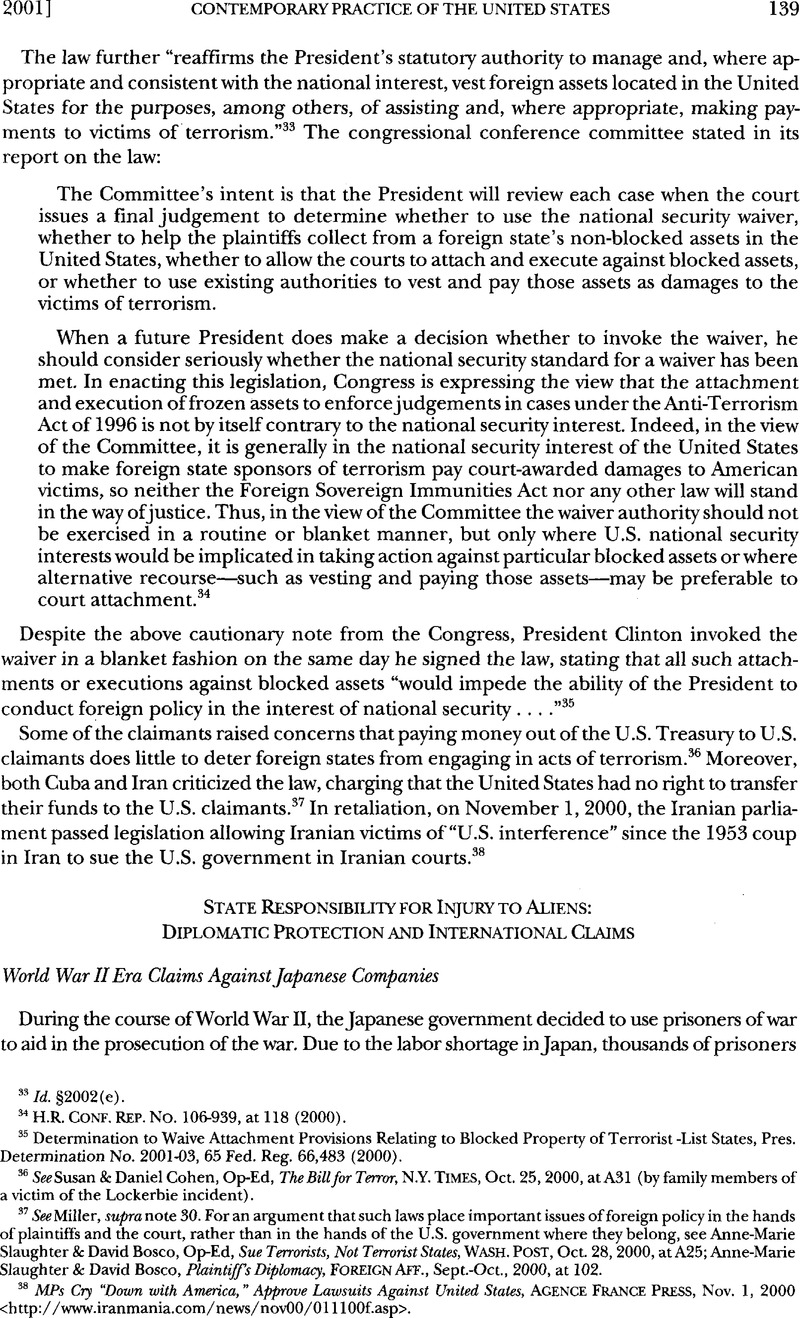No CrossRef data available.
Article contents
World War II Era Claims Against Japanese Compani
Published online by Cambridge University Press: 30 March 2017
Abstract

- Type
- Contemporary Practice of the United States Relating to International Law
- Information
- Copyright
- Copyright © American Society of International Law 2001
References
1 See 1 The Tokyo Judgment: The International Military Tribunal for The Far East 414, 416 (B. V. A. Roling & C. F. Rüter eds., 1977). Among those sent to Japan were soldiers who, after surrendering at Bataan in the Philippines on April 9, 1942, were forced to make the infamous 60-mile “death march.”
2 See Convention [No. IV] Respecting the Laws and Customs of War on Land, Oct. 18, 1907, annex, Art. 6, 36 Stat. 2277, 2297, 1 Bevans 631, 644, reprinted in 2 AJIL 90 (Supp. 1908). Japan was not a party to the Convention Relative to the Treatment of Prisoners of War of July 27,1929,47 Stat. 2021,118 LNTS 343, which contained more detailed provisions on labor by prisoners of war. Nevertheless, Japan stated in 1942 that it would abide by the 1929 treaty’s terms. See The Tokyo Judgment, supra note 1, at 49.
3 Cal. Civ. Proc. Code §354.6 (West Supp. 2000).
4 Statement of Interest of United States of America, In re World War II Era Japanese Forced Labor Litigation, 114 F.Supp.2d 939 (N.D.Cal. 2000) (No. MDL-1347) (filed May 22, 2000).
5 Treaty of Peace with Japan, Sept. 8, 1951, 3 UST 3169,136 UNTS 45. The U.S. Senate gave advice and consent to the treaty in 1952 by a vote of 66 to 10. See 98 Cong. Rec. 2594 (1952).
6 Former U.S. World War II POW’s: A Struggle for Justice, Hearing Before the Senate Comm. on the Judiciary, 106th Cong. 14, 14-15 (2000) (statement of U.S. State Department Deputy Legal Adviser Ronald J. Bettauer).
7 See Murphy, Sean D., Contemporary Practice of the United States, 93 AJIL 883, 885 (1999)Google Scholar, 94 AJIL 682 (2000).
8 Former U.S. World War II POW’s: A Struggle for Justice, Hearing Before the Senate Comm. on the Judiciary, 106th Cong. 47 (2000) (Department of Justice responses to questions posed by Senator Hatch).
9 Diplomatic Note from the Embassy of Japan to the U.S. Department of State (Aug. 8, 2000) (on file at GWU). For an example of Japanese nationals who, having had their claims against the U.S. government waived by the 1951 Treaty of Peace, unsuccessfully sought to sue the Japanese government instead, see Katayama v. Japan, 6 Kōmu GEPPŌ2089 (D. Hiroshima, Oct. 10, 1960), translated in 7 Japan Ann. Int’l L. 125 (1963).
10 Statement of Interest of United States of America, In re World War II Era Japanese Forced Labor Litigation, 114 F.Supp.2d 939 (N.D. Cal. 2000) (No. MDL-1347) (filed Aug. 9, 2000).
11 Id. at 12-14 (citations and footnote omitted).
12 Id. at 15 n.7.
13 Id. at 35 (footnote omitted).
14 The court’s decision does not address plaintiffs who were not nationals of parties to the 1951 Treaty of Peace. Disposition of their claims will require further proceedings.
15 In re World War II Era Japanese Forced Labor Litigation, 114 F.Supp.2d 939, 945 (N.D. Cal. 2000).
16 Id. at 947.
17 Id. at 948 (citing Kolovrat v. Oregon, 366 U.S. 187,194 (1961) and Sullivan v. Kidd, 254 U.S. 433,442 (1921)).
18 Id. (citing Dames & Moore v. Regan, 453 U.S. 654, 679-80 (1981) and Neri v. United States, 204 F.2d 867, 868-69 (2dCir. 1953)).
19 Id. at 948-49.




